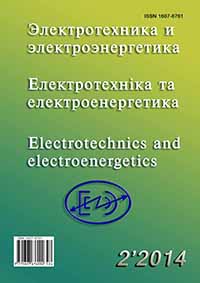TRANSIENTS MODELING IN TRANSFORMERS ON THE BASIS OF MAGNETOELECTRIC EQUIVALENT CIRCUITS
DOI:
https://doi.org/10.15588/1607-6761-2014-2-8Keywords:
magneto-electric equivalent circuit, graph-scheme, magnetic currents, magnetic condensersAbstract
The mathematical model of numerical calculation of transients in electromagnetic devices with complicated load on the basis of nonlinear magneto-electric equivalent circuits of any complexity is developed. On the basis of the developed mathematical model, the method of state variables with application of the equations according to currents and voltages of Kirchhoff’s rules obtained by topological way is used. Thus uniformity for automatic drawing up of the condition equations of magneto-electric equivalent circuits is obtained. Convenience of application of the controlled sources of voltage and current which are widely used in magneto-electric equivalent circuits at the description of interaction of electric currents and magnetic fluxes is also reached. It is offered to use «magnetic currents» and «magnetic condensers» with a differential capacity in magnetic circuits models. On the basis of mathematical model the program complex Colo is developed. This complex provides modeling of the magneto-electric circuits containing greater than 300 elements and it has the increased speed of calculations in comparison with the existing program complexes and gives the steady solution with a less error. The mathematical model is executed so that the results of calculation are time dependences of currents (magnetic fluxes) and voltage drops for all elements of circuit for any configurationReferences
Dommel Hermann W. EMTP theory book / Hermann W. Dommel. – British Columbia : Microtran Power System Analysis Corporation Vancouver, 1996. – 631 p.
Шакиров М. А. Анализ неравномерности распределения магнитных нагрузок и потерь в трансформаторах на основе магнитоэлектрических схем замещения. / М. А. Шакиров // Электричество. – 2005. – № 11. – C. 15–27.
Шакиров М. А. Расчет несимметричных режимов работы трансформаторов с учетом намагничивания стали. /М. А.Шакиров // Электричество. – 2006. – № 6. – C. 21–33.
Lindberg E. ANP3 & NAP2 – A package for circuit and systems simulation / E. Lindberg // Proceedings of the 2’nd International Conference on Engineering Software, 24 March. – London, England, 1981. – P. 686–700.
Хайнеман Р. PSPICE Моделирование работы электронных схем / Р. Хайнеман. – М. : ДМК, 2005. – 325 с.
Дьяконов В. Simulink 4. Специальный справочник. / В. Дьяконов. – СПб. : Питер, 2002. – 528 с.
Влах И. Машинные методы анализа и проектирования электронных схем / И. Влах, К. Сингхал. – М. : Радио и связь, 1988. – 560 c.
Чуа Л. О. Машинный анализ электронных схем: Алгоритмы и вычислительные методы / Л. О. Чуа, ПенМин. Лин; [пер. с англ.]. – М. : Энергия, 1980. – 640 с.
Сигорский В. П. Алгоритмы анализа электронных схем./ В. П. Сигорский, А. И. Петренко. – М. : Сов. радио, 1976. – 608 с.
К. Де Бур. Практическое руководство по сплайнам. Пер. с англ./ К. Де Бур. – М. : Радио и связь, 1985. – 304 с.
Elleuch M. Three phase, three limb transformer model for switching transient calculations. Part 1: Parameter definition and identification / M. Elleuch, M. Poloujadoff // Acta Technica Csav. – 1988. – No. 1. – P. 100–117.
Downloads
How to Cite
Issue
Section
License
Copyright (c) 2017 S. M. Tykhovod

This work is licensed under a Creative Commons Attribution 4.0 International License.
Creative Commons Licensing Notifications in the Copyright Notices
Authors who publish with this journal agree to the following terms:
Authors retain copyright and grant the journal right of first publication with the work simultaneously licensed under aCreative Commons Attribution License that allows others to share the work with an acknowledgement of the work's authorship and initial publication in this journal.
Authors are able to enter into separate, additional contractual arrangements for the non-exclusive distribution of the journal's published version of the work (e.g., post it to an institutional repository or publish it in a book), with an acknowledgement of its initial publication in this journal.
Authors are permitted and encouraged to post their work online (e.g., in institutional repositories or on their website) prior to and during the submission process, as it can lead to productive exchanges, as well as earlier and greater citation of published work.

